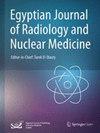Unveiling spindle cell lipoma: a radiological case report
IF 0.5
Q4 RADIOLOGY, NUCLEAR MEDICINE & MEDICAL IMAGING
Egyptian Journal of Radiology and Nuclear Medicine
Pub Date : 2024-09-12
DOI:10.1186/s43055-024-01357-1
引用次数: 0
Abstract
Spindle cell lipoma is a benign adipocytic tumour, commonly occuring in the subcutis of posterior neck, upper back and shoulder, particularly in middle aged males. It is often composed of relatively equal ratio of fat and spindle cells, yet either component may predominate. Because of its variable ratio, a spindle cell lipoma may mimic liposarcoma radiologically. This article aimed to describe the MRI characteristics that assist in diagnosing spindle cell lipoma. Case presentation: A 45-year-old female presented with a gradually progressive neck swelling along the posterior aspect over a period of 2 years. Physical examination revealed a firm, mobile, non-tender mass in the left suboccipital region. Radiographic imaging showed a well-defined heterogeneous, minimally enhancing soft tissue swelling with areas of macroscopic fat and multiple macrocalcifications in the left suboccipital region extending to the left parapharyngeal space, showing loss of fat plane with adjacent muscles. Differential diagnoses of soft tissue neoplasms such as atypical lipoma and low-grade liposarcoma were considered. Surgical excision confirmed a myxoid variant of spindle cell lipoma upon histopathological examination. Spindle cell lipomas, commonly found in the posterior neck, have varied imaging features that are not distinctive. Despite their non-specific nature, radiologists should recognize these features, as the tumor can be treated effectively with simple excision. When encountering a well-defined, complex fatty mass in the subcutaneous tissue of the posterior neck, consider a diagnostic possibility of spindle cell lipoma.揭开纺锤形细胞脂肪瘤的神秘面纱:一份放射学病例报告
纺锤形细胞脂肪瘤是一种良性脂肪细胞肿瘤,常见于颈后部、上背部和肩部的皮下,尤其是中年男性。它通常由比例相对相等的脂肪和纺锤形细胞组成,但其中任何一种成分都可能占主导地位。由于其比例可变,纺锤形细胞脂肪瘤在放射学上可能与脂肪肉瘤相似。本文旨在描述有助于诊断纺锤形细胞脂肪瘤的核磁共振成像特征。病例介绍:一名 45 岁的女性,2 年来颈部后部逐渐肿胀。体格检查发现左侧枕下区域有一个坚实、活动、无触痛的肿块。放射影像学检查显示,左枕骨下区域有一个界限清晰的异质性、微增强的软组织肿物,肿物内有大块脂肪区域和多个大钙化,肿物一直延伸到左侧咽旁间隙,显示脂肪平面与邻近肌肉消失。考虑了非典型脂肪瘤和低级别脂肪肉瘤等软组织肿瘤的鉴别诊断。手术切除后,经组织病理学检查证实这是一种肌样变异的纺锤形细胞脂肪瘤。纺锤形细胞脂肪瘤常见于颈部后方,其影像学特征多种多样,没有特异性。尽管这些特征不具有特异性,但放射科医生仍应加以识别,因为这种肿瘤只需简单切除即可得到有效治疗。当在颈后部皮下组织发现界限清楚的复杂脂肪肿块时,应考虑诊断为纺锤形细胞脂肪瘤的可能性。
本文章由计算机程序翻译,如有差异,请以英文原文为准。
求助全文
约1分钟内获得全文
求助全文
来源期刊

Egyptian Journal of Radiology and Nuclear Medicine
Medicine-Radiology, Nuclear Medicine and Imaging
CiteScore
1.70
自引率
10.00%
发文量
233
审稿时长
27 weeks
 求助内容:
求助内容: 应助结果提醒方式:
应助结果提醒方式:


